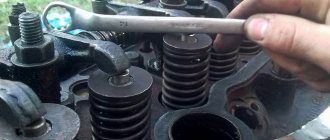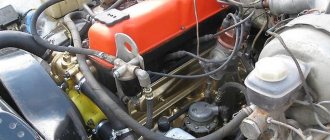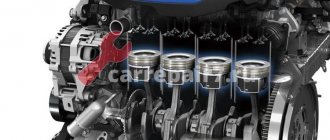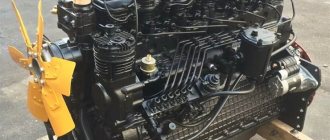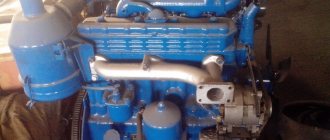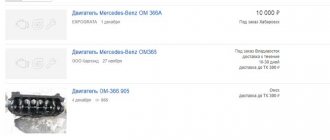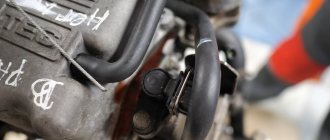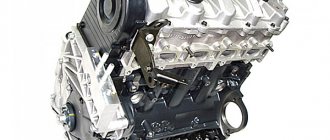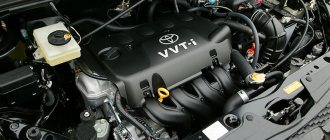Model features
The crawler tractor is based on a rectangular welded frame with reinforcements. The chassis carriage balancers are attached to the frame side members. The drive sprocket is located at the rear, and a guide wheel is installed at the front. It is equipped with a shock absorption mechanism and a device for tensioning the track.
The tractor is equipped with a starting system from a separate gasoline engine. Such a system allows you to operate machines at low temperatures, since there is no risk of battery discharge. The DT crawler bulldozer can be equipped with a PZHB-200 pre-heater, which warms up the cooling system and oil pan. The installation consumes no more than 3.5 kg of fuel per hour and ensures easy starting of the power unit at temperatures of minus 30°C and below.
Technical data
| Machine type | DT - 75 |
| Traction class | 3 |
| Engine | D-440-22(A-41) |
| Operating Power(HP) | 95 |
| Crankshaft speed at operating power (rpm) | 1750 |
| Specific fuel consumption at operating power (g/hp.h.) | 175 |
| Torque reserve coefficient in traction mode (%) | 35 |
| Number of forward gears (with speed reducer, with reverse gear) and reverse gears (with speed reducer, with reverse gear) | 7 (23,14) 1 (5,7) |
| Forward speed range (km/h) main with speed reducer with reverse gear | 5,3…11,2 0,33…11,2 3,17…11,2 |
| Longitudinal base (mm) | 1612 |
| Track (mm) | 1330 |
| Ground clearance (mm) | 380 |
| Track width (mm) | 390 or 470 |
| Length (with attachment in transport position) (mm) | 4400 |
| Width (mm) | 1850 |
| Height (mm) | 2710 |
| Operating weight (kg) | 6950 |
| Average soil pressure (kPa) | 41,5 |
The tractor is equipped with a four-cylinder, four-stroke diesel engine SMD-18N, liquid-cooled and turbocharged. The main engine is started from the driver's seat using a starting engine with an electric starter. To heat the engine before starting it, the tractor is equipped with a pre-start heater PZHB-200. The tractor components and mechanisms are mounted on a welded frame, which consists of two longitudinal welded spars of a closed rectangular cross-section, interconnected by transverse links. The clutch is dry, double-disc, permanently closed. The gearbox and rear axle are mounted in one housing. The rear axle has two single-stage planetary rotation mechanisms with band brakes, providing braking of the tractor both in forward and reverse. The planetary mechanism allows you to reduce the effort on the tractor turning control levers. The tractor transmission, chassis, PTO, and rear linkage mechanism are completely unified with similar parts and assemblies of the DT-75 and DT-75M tractors. The chassis consists of drive and guide wheels, support rollers with rubber bands, four balance suspension carriages and two track chains. To work with beet harvesters, a unified narrow caterpillar track is installed on the tractor. The tractor is equipped with a separate-unit hydraulic system, a rear linkage mechanism with an automatic coupler, which allows you to connect machines and implements using two-point and three-point schemes, and a tow hitch. The hydraulic system and attachment are unified with the DT-75 and DT-75M tractors. The cabin is a closed type, all-metal, two-seater, sealed and sprung, equipped with an air cooler and a heater. The seat is adjustable according to the weight and height of the driver. To improve visibility, the cabin is shifted to the right of the tractor axis, and the fuel tank is located on the left side of the cabin. Served by a tractor driver.
Specifications
Tractors of the DT-75 family are equipped with liquid-cooled diesel engines of several models. The engines use a power system consisting of an air cleaner, a high-pressure fuel pump and injectors. The D-440 engine is equipped with a turbocharger, the rest of the engines are naturally aspirated.
Fuel consumption depends on the engine model:
- 7.2 l per hour - for diesel engine SMD-14;
- 11.4 l per hour - for A-41.
The tractor is equipped with 2 fuel systems: for diesel and for the starting engine. For the second, a mixture of gasoline and oil is used, stored in a tank with a volume of 2.6 liters. Gasoline consumption when plowing depends on the number of engine starts. One launch takes about 0.05-0.1 liters of fuel mixture. The volume of the fuel tank installed at the rear or side of the cab depends on the modification and ranges from 215-315 liters.
The tractor is equipped with a permanently engaged clutch circuit. The design includes two dry friction disks located in the internal cavity of the motor flywheel. The operation is controlled mechanically using a pedal. Transmission 7-speed, mechanical, with creeper. The maximum speed of the tractor is reached in 7th gear and is 11.5 km/h. Using a creeper allows you to work at a minimum speed of 0.33 km/h.
The weight of the machine with the A41 diesel engine is 6530 kg, which is comparable to how much the C1002 tractor of a similar design weighs.
Important changes
The first major modernization was carried out in 1967. The DT-75M modification even received its own name - Kazakhstan.
The “Kazakhstanets” differed from its predecessor in its power unit. The car was equipped with an A-41 engine, the power of which was 90 hp. With. with a working volume of 7.45 liters.
Despite the increased power, specific fuel consumption decreased and amounted to 185 g/l. With. at one o'clock. The new engine weighed more - 930 kg, which means the weight of the tractor also increased.
Now it reached 6350 kg with a ground pressure of 0.48 kg per square meter. cm. But at the same time, the production of a modification with the SMD-14 engine continued.
The reason is the low cost of such machines. The increase in traction characteristics of the DT-75 made it possible to expand the list of equipment: moldboards, plows, harrows, cultivators, seeders, sprayers, irrigation equipment - this is not a complete list of devices..
Repair of DT-75
To ensure the functionality of the machines, it is necessary to carry out regular maintenance of the equipment in accordance with the repair manual. On the DT-75, transmission units, chassis and brake bands are subject to frequent breakdowns and wear.
When operating a tractor, the transmission requires routine maintenance:
- The clutch adjustment is carried out after 240 hours of operation. By adjustment we mean setting the gap between the release levers and the release bearing housing.
- Adjusting the rotation of the tractor consists of adjusting the travel of the brake pedals and the free travel of the brake control levers of the planetary gearboxes.
If noise occurs during transmission operation, the gearbox must be repaired. Final drive repair is necessary when leaks occur or drive gears are damaged.
There is an option to convert DT-75 tractors to wheels. For this purpose, a differential and axle shafts from a ZIL-130 truck are installed. A beam assembly from a truck is mounted at the front on leaf springs. The steering is hydrostatic with a fluid dispenser. A wheeled tractor is more economical and can tow trailers weighing up to 20 tons.
Tape repair
If there are problems with turning the tractor, it is necessary to adjust the free play of the control levers. To make the adjustment, remove the covers and then tighten the brake band adjusting nut. Tightening is carried out until the groove on the lever coincides with the spring ear. After this, the fixing screw and locknut are tightened. Additionally, it may be necessary to adjust the length of the connecting rod from the pedals to the mechanisms.
Clutch adjustment
The setup is done on the go with the participation of an assistant. To adjust the clutches, there are hex nuts removed from the crankcase.
Setup steps:
- Engage first gear and move off.
- Depress the left clutch pedal. If it does not spin, then you need to loosen the nut.
- Carry out a similar setup for the right node.
- Check the work. When two clutches are disengaged, the tractor must stop.
Rear axle
Repair may be required if oil leaks from the joints of the final drive and crankcase or if the main pair is noisy. During the work, the condition of the brake mechanisms is checked, the position of the belts is adjusted and the connecting rods of the drive are adjusted.
Engine repair
The engine is repaired when extraneous noise appears, increased oil consumption and the appearance of smoky exhaust. These signs are accompanied by a decrease in engine power and difficulty starting. For repairs, the engine is removed from the tractor and disassembled on a stand. The removed parts are checked for mechanical damage. Cracks in the block and head are unacceptable, since gas exchange with the atmosphere or mixing of oil and coolant occurs through them.
The cylinder block is equipped with replaceable cast iron liners, which during repairs are replaced with parts of the nominal size. At the same time, the rings are changed and the condition of the main and connecting rod bearings is checked. If damage is detected on the working surfaces, the crankshaft is sent to the workshop for grinding to repair size. If the tractor system was operated on water, it is recommended to wash the jacket with special compounds that remove scale and deposits.
When assembling the engine, it is necessary to set the valve timing. The finished engine is run in on a stand or on a tractor. During break-in, it is necessary to monitor the oil pressure in the lubrication system and prevent operation at high speeds. After running in, the mounting bolts are tightened and the oil in the crankcase is replaced.
Chassis
Repair and maintenance of the undercarriage consists of tensioning the tracks, lubricating the hubs and replacing worn components.
Chassis elements can be qualitatively restored in an industrial environment; it is difficult to do the work yourself in a domestic environment.
When worn out, track pins cannot be restored and must be replaced. Links can be restored by plastic deformation or electric arc surfacing. When performing routine repairs, the links are rearranged to the other side. Due to this, the link engages with the drive wheel at the other edge of the lantern hole.
Track rollers and rollers can be restored by pressing on rings made of 45 steel with a thickness of 10 mm. Electroslag surface restoration followed by turning on a lathe is possible. Cracks on the surface and spokes of the guide wheel are welded. If the mounting holes for the bearings are worn out, repairs with the installation of steel bushings with a wall thickness of 3-4 mm are allowed. The drive wheels are switched to the other side, which ensures uniform tooth wear.
Tractor DT 75 technical characteristics, repair, description and photo
The DT 75 crawler tractor is designed to perform a variety of tasks in the agricultural sector. It is successfully used in all countries of the former USSR, and over the entire period of production of the tractor and its modifications, more than 2 million copies have been sold.
Dt 75 tractor
Its purpose is to work in agriculture with semi-mounted, mounted, trailed, non-hydropowered and hydropowered implements and machines at high speeds, mainly in steppe and forest-steppe zones.
The tractor is also used for construction, transport, reclamation, loading and unloading and other work. The DT-75 tractor was used to create a peat (swamp) modification.
Tractor engine DT 75
Depending on what engine is installed on the tractor, it will have the brand:
- — engine SMD-18n — DT-75n
- - engine A-41 - DT-75d
- - engine RM-120 - DT-75rm
DT75 technical specifications
The DT-75 tractor provides comfortable and safe working conditions, primarily due to the characteristics of the installed cabin - sealed, isolated from noise and vibration. An air cooler, a heater, and an adjustable sprung seat are also installed in the cabin.
For high-quality visibility from the cabin, front and rear windshield wipers are installed, and a washer is installed on the front glass.
The tractor is also equipped with equipment that allows the use of additional units: towing and rear linkage devices, implement drive, single-speed power take-off shaft, hydraulic control system and removable ballast weights at the front.
The cabin has an additional seat for a passenger. To ensure a smooth ride, a balanced spring suspension is installed on board. If desired, the tractor can be equipped with an additional reverse gearbox or creeper.
Repair of DT 75 tractors, the most common breakdowns
The DT 75 tractor is highly popular due to its technical characteristics. It is economical, durable and easy to use. But one of its most important advantages is good maintainability. Current tractor repairs can be carried out by local specialists, but major repairs must be carried out at special enterprises.
Routine repair of tractors is usually required due to dirt or foreign objects getting into mechanisms and components, errors in assembly after repair work, varying degrees of wear of parts, as well as failure to comply with the rules of technical care of the tractor.
Let's consider cases of repair of the DT 75 tractor, when there was a need to replace parts
1. The engine does not start. One of the reasons for this problem is insufficient compression in the cylinder, caused by failure or wear of the piston rings. This is determined by turning the starting motor flywheel. In this case, the worn piston rings need to be replaced. If clouds of smoke come out of the exhaust pipe when the crankshaft rotates, then the cause of the problem is caused by damage to the high-pressure pipes. Otherwise, if white smoke comes from the exhaust pipe, then the faulty injector must be replaced.
2. If the engine runs intermittently, this means that the injector needle is stuck. It needs to be replaced. If this does not help, you need to check the high pressure pipe for damage.
3. Insufficient compression was detected in the pressure cylinders. In this case, the piston rings require replacement.
4. If the engine is running, blue or white smoke comes out of the exhaust pipe. The cause of this problem is the piston rings. It can be eliminated by replacing worn rings with new ones.
5. If strong metallic knocks are heard in the lower part of the crankcase, then the connecting rod or main bearings may have melted. Then you need to replace the connecting rod or main bearings.
6. If the pressure gauge shows lower than acceptable values or does not show oil pressure at all, there may be a problem with the drain valve spring. Then it needs to be replaced. There may also be a problem with the oil pressure sensor or indicator.
7. If the torque multiplier clutch slips, you need to check the drive plate lining for wear.
8. If the brake of the torque multiplier is slipping, you need to check the spring of the brake lever for strength.
9. If the torque multiplier lubrication system pressure gauge readings are missing, or the pressure readings are below acceptable values, the pressure gauge itself may need to be replaced.
10. If the tractor pulls to the sides while operating the tractor on a level surface, you need to check the lining of the sun gear brake bands for suitability.
11. If the tractor does not turn when the control lever is pulled back completely and the stopping brake pedal is pressed, the problem is that the stopping brake band linings are worn out.
12. If the implement or machine mounted on the tractor is not controlled by raising or lowering, you need to check the hydraulic system pump. It is necessary to replace the oil seal or special sealing ring in the suction pipe. If this does not help, the entire pump must be replaced.
13. If oil or foam is released through the oil tank breather, check the cylinder piston seals for wear. The hydraulic pump drive gear shank seal may have failed.
14. If it is noticed that the generator operates intermittently, the springs and brushes of the generator armature need to be replaced. You also need to check the starter for malfunction.
15. If the crankshaft does not turn in the starting engine when the starter is rotating, you need to replace the flywheel ring or drive.
16. If it is not possible to obtain charging current readings on the ammeter, you need to replace the fan drive belt, or check the generator for a malfunction.
17. If a knocking sound is heard in the drive wheel teeth and the teeth slip, then the track pins and drive wheel teeth need to be replaced due to wear.
Gearbox DT 75 description and characteristics
Gearbox DT 75 is a seven-speed, four-speed gearbox, all parts of which are located in the front compartment of the cast power transmission housing.
Attachments
Tractors of the DT-75 family are equipped with front- and rear-mounted attachments.
The following equipment is available for the machines:
- bulldozer blade with fixed and rotating blade;
- a drilling rig with a fixed drill diameter for working on soil without crushed stone or pebbles;
- drilling station with replaceable drills;
- installation for laying trenches;
- earth-moving cutter for frozen soil;
- soil loosener with 3 working teeth;
- rotary snow blower;
- pipelayer;
- mobile welding station;
- pumping unit;
- sprinklers.
When working with a plow on the DT-75, equipment from other tracked vehicles can be used. The attachment is carried out to 2 or 3 attachment points on the rear of the tractor. Before adjusting the plow, the tractor must be placed on a flat surface and the technical condition of the components and the fixation of the hitch must be checked.
Setting the plowing depth on the plow is as follows:
- Place the tractor on boards with a thickness equal to the planned plowing depth minus 20 mm (the depth of soil subsidence when moving).
- Put the plow into working condition.
- Set the plow parallel to the ground using the right brace and top link.
- Set the depth with the reach of the plow support roller strut. The wheel is placed on a stand with a height equal to the plowing depth minus 25 mm (compensation for subsidence of the wheel into the ground).
- Tighten the position clamps of the support wheel stands.
Do-it-yourself blade
The blade consists of a frame, a working surface and a hydraulic cylinder. Ready-made units or a channel with additional reinforcements are used as a frame. The blade is made of steel sheet 8-10 mm thick and is additionally reinforced along the rear surface. The homemade structure must withstand heavy loads encountered during operation. It is possible to install a rotary blade controlled by a separate hydraulic cylinder. Hydraulics are controlled from the operator's cabin.
PURPOSE AND GENERAL STRUCTURE OF THE DT-75 TRACTORThe general-purpose tracked agricultural tractor DT-75 (Fig. 1 and 2) belongs to the traction class of 3 tons. It is designed to work in agriculture with mounted, semi-mounted, trailed hydraulically and non-hydroficated machines and implements at high speeds, mainly in the steppe and forest-steppe zones.
The tractor can be used for light construction, reclamation and other work.
The DT-75 is equipped with a four-cylinder SMD-14 engine with a power of 75 hp. (at 1700 rpm of the engine crankshaft) Kharkov Engine Building. The engine is located on the front of the tractor frame.
The SMD-14 engine is a four-stroke diesel engine with vortex-chamber mixture formation and water cooling; it is lightweight and economical to operate. The engine is equipped with a single-cylinder starting gasoline engine PD-10U with a power of 10 hp. with electric starter, dry double-disc clutch of a permanently closed type. An electric torch heater is installed on the diesel suction manifold, making it easier to start the diesel engine at low ambient temperatures.
On the right side of the engine there is an NSh-46U oil gear pump for the hydraulic system and a G-214-A1 DC generator with a power of 180 W.
The power of the SMD-14 engine allows the DT-75 tractor to develop a nominal traction force of 3 g in first gear at a travel speed of 5.15 km/h.
The SMD-14 engine is mounted on an elastic automobile-type suspension and attached to the tractor frame at four points.
To protect from dirt and dust, the engine is covered on all sides by a hood. In front of the engine there are water and oil radiators, covered with a canvas curtain.
Behind the engine is the tractor's power transmission, which includes the main clutch, cardan (connecting) transmission, torque multiplier (UK.M), gearbox and rear axle, mounted in one cast housing, final drives and dependent power take-off shaft ( PTO).
The planetary torque booster installed on the tractor is designed to increase traction effort in all gears by 25% by reducing the speed of the tractor, which allows the tractor to overcome short-term additional resistance to movement without stopping to change to a lower gear, and also receive two reserve gears with traction force more than 3 tons and speed less than 5 km/h.
A seven-speed manual gearbox and a rear axle with a planetary steering mechanism are mounted in one cast iron housing, which improves the operating conditions of the transmission due to increased structural rigidity. The rear axle has two single-stage planetary steering mechanisms with band brakes.
The main gear consists of a pair of bevel gears, the final drive - of a pair of spur gears.
The power take-off shaft is a dependent type, driven from the drive shaft of the torque multiplier through a gearbox attached to the rear wall of the transmission housing. The power take-off shaft is switched on and off using a lever located in the tractor driver’s cab.
All units and mechanisms of the tractor are placed on a rigid and durable welded frame, consisting of two longitudinal welded spars of a closed rectangular cross-section, connected to each other by transverse bars and axles.
The rear brackets of the frame are equipped with a towbar and a linkage linkage mechanism with the main power cylinder of the hydraulic system, which allows the tractor driver to control the operation of mounted, semi-mounted or trailed hydraulic machines and implements from the cab without the help of additional maintenance personnel.
Overview of modifications
The basic model DT-75 became the basis for several modifications, which were produced at different times and used in various sectors of the national economy. Modifications differ in engine type, cabin type and equipment, and track width. The transmission and caterpillar drive on the machines are of the same design.
DT-75M
The tractor has been produced by the Volgograd and Pavlodar plants since 1967. Visually it is distinguished by a rounded cabin with an increased roof height. Equipped with an A-41 naturally aspirated diesel engine with a displacement of 7.43 liters and a power of 90 hp. The tank holds 245 liters of fuel and is located at the rear of the cabin.
DT-75B
Machine for use on weak or marshy soils. Initially created for peat mining, it was produced only in Volgograd. Cab with a high roof, similar to the 75M model. The power plant is an SMD-14NG diesel engine with a displacement of 6.3 liters and a power of 80 hp. The track width was increased to 470 mm, which made it possible to reduce the specific ground pressure from 0.44 to 0.23 kg/cm². The lower part of the machine is equipped with steel sheets that protect the components from damage and contamination.
DT-75K
Special version for working on surfaces with slopes up to 30° (standard machines are designed for an angle of 20°). The tractor allows a lateral tilt of 20°, versus 15° for other DT-75 models. Created for work in quarries, produced in Volgograd. The chassis and power unit are similar to the 75B model. The weight of the tractor filled with fuel and technical fluids is 8350 kg.
Externally, the tractors were distinguished by a special cabin, which was equipped with two seats installed opposite each other. The cabin had a roll indicator, which was used to control the operating angles. Due to the modified cabin, a tank volume reduced to 215 liters was used.
DT-75S
An agricultural version of the machine, designed to work with units for T-150/150K tractors. It is distinguished by the installation of a V-shaped 6-cylinder diesel engine SMD-66 with a turbocharger with a capacity of 170 hp. The transmission is equipped with a 2-speed PTO (540 and 1000 rpm).
The cabin is rectangular in shape, designed for 2 people, equipped with a front and rear window cleaning system, sun blinds and a visor, and a standard place for installing a thermos. The cabin design provides protection from vibration and dust.
Technical characteristics of the first model DT-75
In 1963, the DT-75 caterpillar tractor developed by VgTZ specialists was put into production. Subsequently, the model was modernized several times.
The changes made by the designers did not affect the design of the DT-75 bulldozer, the technical characteristics of which initially looked like this:
- Engine SMD-14. The diesel power unit had four cylinders, a water cooling system, with a working volume of 6.33 liters, and developed a power of 75 hp. With. and consumed 195 grams of diesel fuel per horsepower per hour. The role of the starting device was performed by the PD-10M-2 gasoline engine. In this version, the weight of the DT-75 engine was 675 kg.
- The clutch is a double-disc, dry, with coil springs and a mechanical control drive.
- The gearbox is a seven-speed, four-way, seven forward gears and one reverse gear. To improve the traction characteristics of the DT-75 tractor, the gearbox was equipped with a torque amplifier (TMA), which can be switched off from the cab if necessary. This made it possible to accelerate to 10.85 km/h when moving forward, and to 4.41 km/h when moving backwards.
- The rear axle is combined with a gearbox, final drives in one cast housing, divided by partitions into compartments, and a belt-type braking system. To access these units during repairs, it is necessary to remove the covers located on the top of the housing. A power take-off shaft is mounted at the rear of the transmission, which ensures the operation of attachments.
- Suspension – elastic, balancing type. The support rollers - four on each side - are mounted in pairs on balancing trolleys (carriages) with cylindrical spring springs. The design, despite its simplicity, ensured smooth operation of the suspension. Thanks to this, the DT-75 tractor is more comfortable than its competitors.
- DT-75 tracks consist of complexly shaped cast tracks that are hingedly connected to each other. The design of the tracks ensures the vehicle's maneuverability on soils with the required resource. The standard track width is 390 mm.
- The fuel tank was originally installed on the rear wall of the cabin. The volume of the fuel tank is 245 liters.
- Hydraulic drive. Used when working with attachments, it consisted of components: a gear pump, a distributor, a hydraulic cylinder and a hydraulic oil tank with a capacity of 11 liters. The hydraulic system was controlled from the cabin.
Dimensions of the DT-75 tractor:
- Length (without blade) – 4530 mm.
- Width (along the outer edge of the tracks) – 1760 mm.
- Height (on the roof of the cabin) – 2306 mm.
- Track (along the axis of the tracks) – 1330 mm.
- Base (distance between axles) – 1612 mm.
- Ground clearance – 326 mm.
- Structural weight – 5750 kg.
- The specific ground pressure is 0.44 kilograms per square centimeter.
From the characteristics of the DT-75 tractor it is clear that the machine turned out to be compact. Combined with maneuverability, it made it possible to use equipment in confined spaces.
Advantages and disadvantages
According to owner reviews, the advantages of tractors are as follows:
- the ability to work on soft soil without cutting the top layer with caterpillars;
- engine efficiency;
- machine versatility;
- permeability;
- high traction characteristics.
At the same time, there are disadvantages:
- hydraulic system failures (pump breakdowns, leaks) and low productivity;
- low reliability of electrical circuits;
- oil leaks from the engine;
- low comfort in the cabin;
- risk of injury due to closely located control levers.
Owner reviews and operating features
Numerous reviews from owners and drivers of the tractor indicate that all modifications of DT 75, DT 75B, DT 75S, DT 75T are distinguished by their maintainability. Thanks to the convenient location, as well as the accessibility of the main mechanisms and components, repairs do not take much time. The dimensions of the DT 75 allow for maintenance in small garages. They also note that the only drawback of modern models is the insufficient supply of spare parts. The reason for this is the improvement of most mechanisms in the tractor.
Be sure to read: Interesting things about crawler tractors
The weight of DT 75 makes it possible to work in the fields, exerting minimal pressure on the soil.
Price and owner reviews
DT-75 tracked vehicles are constantly present on the used equipment market. The cost of cars starts from 150 thousand rubles and reaches 1.5 million rubles. The price is influenced by the condition of the tractor, year of manufacture, equipment, and availability of documents.
The production of tractors continues at the Volgograd plant. The cost of the machines depends on the type of motor installed and the set of additional equipment.
Three options are available for ordering:
- basic DT-75 - cost from 2 million rubles:
- bulldozer based on DT-75 - estimated at 2.15 million rubles;
- modernized version of Agromash-90TG - price from 2.4 million rubles.
Alexander, Tver region
A reliable car, the SMD diesel does not cause problems with regular maintenance. Suspension carriages require cleaning and lubrication in accordance with regulations. If this is neglected, the axles and mating parts will break. The tractor is equipped with a standard pre-heater, which simplifies starting the engine at low temperatures. The machine is used for plowing and as a bulldozer.
Andrey, Leningrad region
The tractor is used to clear areas for road construction. When working, pay attention to the cleanliness of the radiator and avoid damage. There are curtains in front of the radiator; damage to this unit causes disturbances in the temperature regime of the engine. When using the machine in swampy areas, it is better to install extended tracks, since the tractor gets stuck on standard ones.
Tractor DT-75 traction class
The tractor belongs to traction class 3. It has a 4-cylinder engine. The engine power of the DT 75 is 100 hp. The working volume of the cylinders is 7.43 liters. Diesel fuel consumption depends on the operating mode, but its average value is 226 g/kWh. The fuel tank capacity is 315 liters. Ground clearance is 0.37 meters. The weight of DT 75 is 6440 kg. Dimensions DT 75: 3480×1890×2650 mm. An electric starter, powered by a battery, is responsible for starting the engine.
Be sure to read: Tractor TT 4
Equipment design
A tractor with sufficient performance and maneuverability has certain design features.
Structure of the 75 DT tractor:
- Engine. The first old-style model with a four-cylinder SMD-14 diesel engine. Machine power 75 hp. With. and a working life of 3 thousand engine hours. The following models have a more advanced SMD-14NG engine. The new engine has the same parameters, but with increased power of 80 hp. With.;
- Transmission. The chassis consists of four gearboxes, a double-disc closed clutch, and band floating brakes. The gearbox has 7 forward and 14 reverse speeds;
- PTO (power take-off shaft). The drive is taken by a speed reducer or gearbox;
- Cold engine start. Ability to work at low temperatures;
- Metal main frame. The two spars are connected by metal pipes;
- Traction performance. Tractor with speed reducers, single-stage reverse gearbox, planetary gearbox, torque evading. Thanks to these features, the manufacturer installed a blade that allows the unit to be used as a bulldozer;
- Cabin. In two places with high tightness, which provides protection from noise and dust. The driver's seat changes position, convenient control system. The cabin is ventilated and heated. There is a roll cage;
- Canopies. Thanks to the towbar, rear linkage and hydraulics, the tractor can be combined with a plow, bulldozer, seeder, and potato planter. A tractor trailer is also attached to the tractor to transport the load. You can use additional canopies that turn the tractor into a loader or concrete paver. When using a tractor, you can cope with various tasks.
LLC "Specialized Supply"
The Volgograd Tractor Plant produces general purpose tracked tractors DT-75N, DT-75D and their modifications, tractors VT-100D, VT-150. In 2005, production of the VT-200 hydromechanical tractor began.
Modifications. DT-75NT, DT-75DT, VT-100DT are swamp vehicles, for working on peat.
The cabin is two-seater, rear-facing, sealed, noise-vibration-insulated, with a heater and air cooler (on VT-100, VT-150, VT-200 with thermoelectric air conditioning), equipped with front and rear windshield wipers and a front window washer. The operator's seat is sprung and adjustable.
Engine. On the DT-75N, the engine is a modified SMD-18N, diesel engine with turbocharging and intercooling, in-line, liquid cooling, 4-cylinder, cylinder diameter and piston stroke 120×140 mm, displacement 6.33 l, compression ratio 15.5, power 73.6 kW (100 hp) at 1,800 min-1, torque 426 N m (43.4 kgf•m) at 1350...1500 min-1, torque reserve 15%;
on DT-75D - modification D-440-22, turbocharged diesel engine, 130x140 mm, displacement 7.43 l, compression ratio 16, power 84.6 kW (115 hp) at 1,800 rpm, torque torque 532.5 N m (54.3 kgf•m) at 1300 min-1, torque reserve 25%;
on DT-75LM - modification D-245.25, turbocharged diesel, 110×125 mm, displacement 4.75 l, compression ratio 15.1, power 79 kW (107 hp) at 2,200 rpm, torque torque 390 Nm (40 kgf•m) at 1400 min-1, torque reserve 20%;
on VT-100D - modification D-442-25I, diesel engine with turbocharging and intercooling, in-line, 4-cylinder, 130x140 mm, displacement 7.43 l, 130x140 mm, liquid cooling, compression ratio 16.5, dual-mode: transport mode - power 111.8 kW (152 hp) at 1750 min-1, torque reserve 15%; traction mode - power 93.4 kW (127 hp) at 1750 min-1, torque reserve 35%, torque 687 N•m (70 kgf•m) at 1300 min-1;
on VT-150 - modification D-442VI, diesel engine with turbocharging and intercooling, in-line, 4-cylinder, 130x140 mm, displacement 7.43 l, 130x140 mm, liquid cooling, compression ratio 16.5, power 115 kW ( 157 hp) at 1,850 min-1, torque 706 N•m (72 kgf•m) at 1,300...1400 min-1, torque reserve 20%;
on VT-200 - modification D-461VSI, diesel engine with turbocharging and intercooling, in-line, 6-cylinder, 130x140 mm, displacement 11.15 l, power 162 kW (220 hp) at 2,000 min-1 , torque 926 Nm (94.5 kgf•m) at 1500...1600 min-1, torque reserve 20%.
Transmission. The clutch on DT-75, VT-100, VT-150 is friction, dry, double-disc, permanently closed, drive with pneumatic booster. Transmission:
on DT-75 - 7-speed, three-shaft, number of gears: forward - 7, reverse - 1, gear ratios: I - 1.786; II - 1.60; III - 1.438; IV - 1.294; V - 1.163; VI -1.045; VII - 0.847; ZH - 2.083;
on VT-100, VT-150 - 5-speed, three-shaft, number of gears: forward - 5, reverse - 1, gear ratios: I - 1.567; II - 1.2647; III - 1.0262; IV - 0.8333; V -0.6547; ZX - 1.5575.
Upon request, a 5-speed speed changer is installed in front of the gearbox, gear ratios: I - 16.195; II - 7.602; III - 3.272; IV - 1.536; V - 1.0, or reverse gearbox, gear ratios: forward 1.67 and 1.0, reverse - 1.346. When the speed changer is turned on, gears V, VI and VII of the main gearbox are prohibited from being used. When equipped with a reverse gearbox, the reverse gear is not installed. The VT-200 has a torque converter, a 4-speed automatic transmission with constant mesh gears and a forced lubrication system.
The rear axle is a bevel-planetary gear with an integrated turning mechanism, gear ratio 4.491. The final drive is single cylindrical, gear ratio 5.461.
On the DT-75, the PTO is dependent, power take-off from the gearbox, gear ratio 3.167, rotation speed 540 min-1; on VT-100 - dependent, power take-off from the gearbox, 2-speed, gear ratios 3.167 and 1.74, rotation speed 540 and 1000 min-1; on the VT-150 - partially independent, when stopping the tractor by disengaging the clutch, the PTO shaft stops, and when stopping the tractor by simultaneously pulling both levers to turn the PTO rotates, 2-stage, rotation speed 540 min-1 and 1000 min-1.
Running device. The suspension is balanced, four (on the VT-200 there are five) road wheels and two support rollers on board. Hydraulic track tensioning mechanism. Upon request, VT-YuODT can be equipped with tracks 750 wide; 470 or 390 mm.
Electrical equipment. Voltage 12 V (in engine start mode 24 V), battery 2 pcs.; on DT-75 generator G700.09.1 (GYuOO.09.1), on VT-100 - 963.3701 (G961.3701 or P000.01.01), on VT-150 - 9632.3701-3, two-level: first level - voltage 12 V, power 1 kW, second level - voltage 24 V, power 2 kW; starting motor P-10UD (P-350-1) or starter ST-142B1 (AZJ3367).
hitch , lever-joint NU-3 with the possibility of two- and three-point adjustment. On the DT-75 the load capacity on the hinge axis is 2,500 kg, on the VT-150 - 4000 kg, on the VT-200 - 4200 kg.
Filling volumes, l: fuel tank - 300 (on DT-75 - 255); cooling system on DT-75 - 19, on VT-100D - 26, on VT-200 - 43; engine crankcase - 22 (with the D-245.25 engine - 12, with the D-461 engine - 35); torque converter on VT-200 - 26; power transmission on DT-75 - 9, on VT-100D - 38, on VT-200 - 53; hydraulic system - 46.
Advantages
The advantage of this unit is its high cross-country ability, thanks to the wide track surface. Based on the type of design, the dimensions of the blade range from 390 to 470 mm, and the ground clearance is from 326 to 380 mm, which allows the DT-75 bulldozer to work on difficult types of soil without compromising productivity and quality of action.
Operation of the DT-75 bulldozer with difficult soil
In addition, with a DT-75 fuel consumption rate of 15 l/h, the bulldozer has the ability to move at speeds of up to 12 km/h.
In addition, the unit has a number of other advantages, namely:
- optimal sizes;
- increased stability;
- high maintainability, i.e., easily replaceable mechanisms;
- significant performance indicators;
- long service life;
- the presence of a pre-start heating element PZHB-200, which allows operation in severe sub-zero temperatures;
- optimal technical characteristics, etc.
To see all the advantages of using the DT-75 bulldozer, you don’t have to look for it on the streets and construction sites - just watch the video on the Internet and you will be convinced that buying or renting this special equipment will be a profitable investment.
Construction of the bulldozer DT-75
Initially, the tractor was equipped with a four-stroke SMD-14 engine with 4 cylinders and a liquid cooling system. It ran on diesel fuel and had a power of 75 l/s.
The construction diagram is presented below.
Diagram of the bulldozer DT-75
The swamp model DT-75B, thanks to the increase in the width of the tracked links, received improved support characteristics. This modification was equipped with an SMD-14NG engine with a power of 80 l/s.
“Please note! At the moment, the DT-75 bulldozer has an A-41 turbocharged diesel unit with a rated power of 90 l/s.”
The DT-75N tractor model is equipped with a turbocharged SMD-18N engine with a power of 95 l/s, started using an electric starter. And such a modification as DT-75DE is equipped with DD - A41SI. Due to the use of such engines, the thrust class has increased to level 5.
The more modern model DT-75A has reverse, creeper, rear hydraulic linkage, the ability to install air conditioning, etc.
The gearbox of the DT-75 earth-moving unit and the rear axle are located in the same housing. Moreover, this special earthmoving equipment has 10 forward gears and 5 speeds when moving backward. This transmission allows you to overcome various unpleasant surprises, including working conditions at a slope of up to 20 degrees.
The clutch is always closed, double-disc, dry.
Band brakes provide good braking quality for any movement.
Initially, this unit had a closed, sealed cabin of the GAZ-51 car. The DT-75M model was equipped with a cab with increased height above the bulldozer driver’s head and control levers bent towards the driver. Now, due to the tightness, sound insulation in the driver’s cabin has been significantly increased, and to maintain a normal temperature inside, you can additionally install an air conditioner or heating system.
In addition, the presence of modern light optics and the location of all instruments and controls are in accordance with all the rules of ergonomics, allowing to increase the operator’s productivity.
Depending on the type of design of the DT-75, stationary or rotary blades can be used.
The blade is a metal structure that covers the width of the bulldozer, with a curved front sheet. When the hydraulic cylinder of the bulldozer DT-75 is operating, due to the pressure of the working fluid, the rod makes reciprocating movements, ensuring the effectiveness of certain manipulations.
The stationary mechanism is used for filling holes, ditches and trenches. The rotary type blade is used for snow removal and other works of this nature.
Thanks to the ability to use a wide range of attachments, for example, scrapers, brush cutters, uprooters, etc., this special equipment is used in almost all areas of the national economy.
Specifications
| Technical specifications | DT-75 |
| Dimensions, mm | 4400x1850-2240x2710 |
| Ground clearance, mm | 326-380 |
| Weight, kg | 7400 |
| Tank capacity, l | 360 |
| KP | Forward -10, reverse - 5 |
| Move | crawler |
| Engine power, l/s | 95 |
| Number of cylinders, pcs | 4 |
| Torque, Nm | 15 |
| Travel speed, km/h | 12 |
| Consumption, l/h | 15 |
| Cost, rub | 800000 |
| Analogs | YTO C1002, VT-90 tractor, etc. |
Principle of operation
If desired, the operator of the DT-75 bulldozer can calculate the work cycle time of the bulldozer, which consists of such points as:
- The working stroke involves deepening and digging the soil, i.e., a certain amount of soil is collected and moved to the unloading site.
- Stopping movement to change gears.
- Idling to return to the original digging position.
- Stopping to shift into forward gear.
Trimmed and separated from the main surface, the soil is collected in front of the knife to the upper level of the working body, after which the moldboard mechanism rises to the level of the ground surface and the contents are simply moved to the unloading site.
"Important!
If leveling along the plane of the cut soil is required, the blade rises evenly during movement.”
High maneuverability, if necessary, allows you to start the cycle from a new place each time.
Nuances of operation
- There are 4 known configurations of the DT-75 tracked earth-moving unit:
- C1 - may have remote cylinders, hydraulic system elements and rear linkage in stock.
- C2 - can be equipped with a hydraulic system tank and distributor.
- C3 - comes without additional equipment, like C1.
- C4 - similar in configuration to C1, but without an external cylinder.
- In order to rent special equipment for transporting the unit to the place of work, you need to provide the lessor with information about how much the DT-75 bulldozer weighs. Previously, it was popular to use railway platforms, but now automobile equipment, which is much cheaper.
